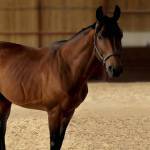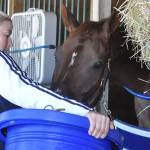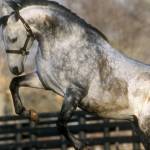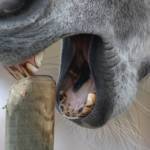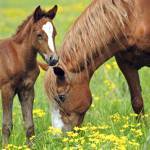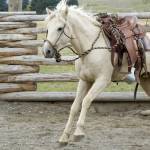Stress Eating: Anticipatory Behavior of Horses at Feeding Time
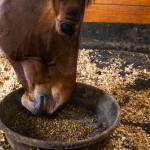
Based on a recent study, domestic horses often show anticipatory and stress-related behaviors around feeding time, particularly in meal-fed horses.* Evaluating anticipatory behaviors may be an easy way to assess well-being, and modifying feeding practices may improve welfare.
According to researchers, anticipatory behaviors occur before an anticipated favorable event and tend to be more pronounced in individuals with fewer opportunities for desirable experiences. These behaviors are conditioned, which means that cues from a caregiver or trainer are associated with a reward. When that reward is positive, like being fed, anticipatory behaviors are expected.
Not all anticipatory behaviors are positive. For example, horses can show stereotypic behaviors such as repetitive head shaking or nodding, windsucking, cribbing, box walking, pacing, weaving, and pawing.
Given this, the presence of anticipatory behaviors may not be positive and could indicate the need for altered management such as ad libitum feeding rather than providing meals.
“Further, stabled horses fed meals may have insufficient foraging opportunities that can negatively affect the gastrointestinal tract, and conditions such as equine gastric ulcer syndrome may develop,” said Catherine Whitehouse, M.S., a Kentucky Equine Research advisor.
To determine which anticipatory behaviors horses display when fed forage either free choice or in meals, six horses were recruited for the study. During the observation period, horses were offered haylage at 4:30 p.m. in haynets prepared by their owners. Horses on free-choice feeding received their haynet regardless of hay remaining, whereas meal-fed horses typically had no hay remaining at the time of feeding. All horses also received a molasses-free chaff meal at 6:30 a.m. and 4:30 p.m. Horses were turned out for three hours each day. The horses’ behaviors were observed beginning one hour before feeding and continued until one hour after feeding. The number of behaviors were recorded. Behaviors were broadly classified as maintenance (eating, resting, lying down, self-grooming); locomotion (walking with purpose or relaxed); investigation (foraging for food, investigation objects in the stall); arousal (tail swishing, vocalizing, stamping, striking, bucking); stereotypies as described above; and others (unclassified).
“Stereotypic behaviors were observed much more frequently in meal-fed horses. These stereotypies were recorded in both the pre- and postfeeding periods, and were significantly more frequent than baseline, which was the period between meals. Further, in ration-fed horses there was a significant increase in stereotypical behaviors as the time of feeding approached,” shared Whitehouse.
This study also found:
- Arousal behaviors occurred more frequently in the post-feeding period of ration-fed horses;
- Investigative behaviors had a higher frequency in the prefeeding period of free-choice-fed horses and in the pre- and postfeeding period of meal-fed horses;
- Locomotion was more frequently noted in the pre- and postfeeding period of free-choice-fed horses and in the prefeeding period of meal-fed horses. Additionally, locomotion decreased as feeding time approached in both groups of horses; however, this decreased motion was more intense in meal-fed horses.
“These results indicate that meal-fed horses exhibit more stereotypical and arousal behaviors, with anticipatory behavior intensifying closer to feeding time. These findings suggest a potential link between feeding stress and anticipatory behavior, especially in horses on ration diets. This study underscores the importance of considering feeding practices in horse welfare management,” wrote the researchers.
“Concerning gastric health, horses that are fed meals—both concentrated feeds and forage—may be at risk of developing gastric ulcers. The upper region of the stomach can experience prolonged exposure to acidic gastric fluids when it remains empty for prolonged periods of time,” explained Whitehouse. “Feeding strategies to support gastric health include maximizing time spent eating through free-choice access to forage or using slow-feed devices to decrease rate of intake and extend time spent eating when free-choice forage is not appropriate.”
Some horses may also benefit from a digestive buffer to help neutralize gastric acidity and decrease the risk of gastric ulcers.
*Mata, F., G. Boyton, and T. Young. 2024. Anticipatory behaviour during the approach to feeding times as a measure of horse welfare. Animals (Basel) 14(24):3677.

